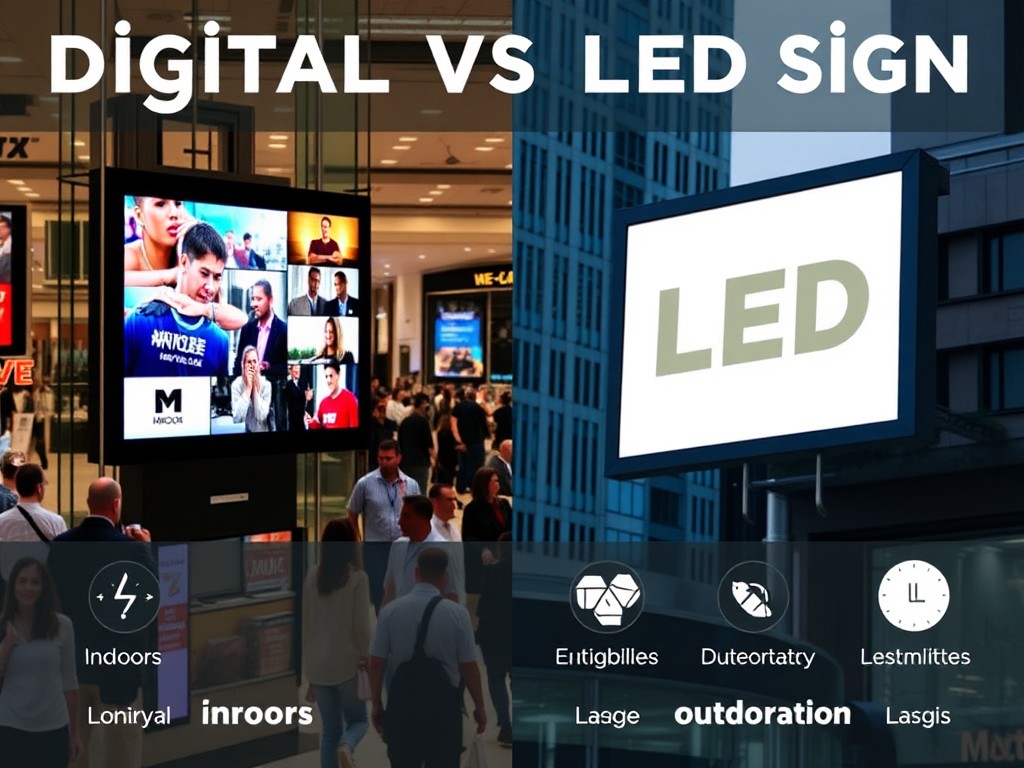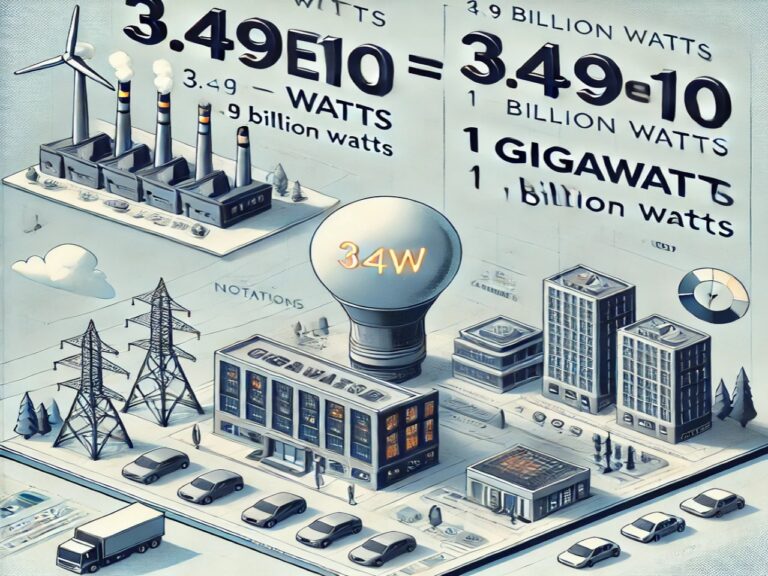Digital vs LED Signs: Understanding the Key Differences for Your Business
In today’s fast-paced technological landscape, businesses face numerous choices when it comes to signage, with digital vs LED signs being two of the most popular options. The type of signage you select plays a crucial role in how effectively your message reaches your audience, whether you’re a small business owner, marketer, or corporate leader. Choosing between digital and LED signs can significantly impact visibility, communication, and brand image. This comprehensive guide will explore the differences between these two signage types and help you determine which is the best fit for your business needs.
What Are Digital Signs?
Digital signs refer to a broad category of electronic displays that are used to convey dynamic content. These signs often utilize LCD, LED, or plasma screens and are capable of displaying video, images, text, and real-time data. Digital signage is highly customizable and can be updated remotely, making it a versatile tool for businesses looking to communicate diverse and frequently changing messages.
Digital signs are often used in settings such as airports, shopping malls, restaurants, and corporate offices. They can display anything from advertisements and announcements to entertainment and news feeds. The ability to switch between different types of content makes digital signage highly engaging, helping businesses keep their messaging fresh and relevant.
What Are LED Signs?
LED signs, on the other hand, are a specific type of illuminated sign that uses light-emitting diodes (LEDs) to display content. These signs are primarily text- or graphic-based and offer bright, clear visibility even in outdoor settings. Unlike traditional neon or fluorescent signs, LED signs are energy-efficient and long-lasting, making them a popular choice for businesses that need continuous operation.
LED signs are commonly used for storefronts, billboards, and other outdoor advertising applications. They are typically more limited in terms of content display compared to digital signs, often showcasing simple text or graphics rather than full-motion video or dynamic multimedia. However, their brightness, durability, and ability to withstand harsh weather conditions make them highly reliable for certain business needs.
Digital vs LED Signs: Key Differences
When comparing digital and LED signs, it’s important to understand their fundamental differences in terms of functionality, content flexibility, cost, and usability. While both options offer benefits, they serve different purposes and excel in distinct environments.
- Content Flexibility:
- Digital signs are capable of displaying a wide variety of content, including video, animations, slideshows, and real-time updates. This makes them ideal for businesses that require frequent content changes or need to display complex information.
- LED signs are generally more static and are best suited for displaying simple text, logos, or basic graphics. While they can be programmed to change messages, they are not typically used for full multimedia displays.
- Cost:
- Digital signs tend to have higher upfront costs due to the advanced technology involved in creating high-resolution displays capable of rendering dynamic content.
- LED signs are usually less expensive initially, though the cost can vary depending on the size and customization required. However, their long lifespan and energy efficiency often make them a more cost-effective option in the long run.
- Usability:
- Digital signage systems usually require more sophisticated software for content management and updates, often necessitating an IT team or a specialized service provider.
- LED signs are typically easier to manage and require minimal technical expertise for operation, making them a more user-friendly option for smaller businesses without dedicated tech support.
- Durability:
- LED signs are known for their durability, particularly in outdoor environments where weather conditions can be harsh. They are resistant to rain, snow, and extreme temperatures.
- While digital signs are also durable, they may not offer the same level of resilience in harsh weather conditions unless they are specifically designed for outdoor use.
- Energy Efficiency:
- LED signs are highly energy-efficient, consuming significantly less power than traditional neon or fluorescent signs. They are an eco-friendly option for businesses looking to reduce energy consumption.
- Digital signs, while more energy-efficient than older forms of signage, typically consume more power than LED signs due to their complex display capabilities.
The Pros and Cons of Digital Signs
Digital signs offer a wealth of benefits for businesses looking to make an impression with dynamic, high-quality displays. However, they also come with certain limitations that may not make them the best choice for every situation.
Pros of Digital Signs:
- Versatile Content Display: With the ability to showcase videos, live feeds, and multimedia presentations, digital signs provide unmatched flexibility in the types of content that can be displayed.
- Remote Content Management: One of the biggest advantages of digital signage is the ability to update content remotely. This is particularly useful for businesses with multiple locations, allowing them to control messaging across all sites from a central system.
- High Engagement: The interactive and dynamic nature of digital signs can capture attention more effectively than static signage. This is particularly useful in high-traffic areas where grabbing attention quickly is crucial.
Cons of Digital Signs:
- Higher Upfront Costs: The initial investment for digital signs can be significant, especially for large or high-resolution displays.
- Complex Installation and Maintenance: Installing a digital signage network can require specialized software, hardware, and ongoing technical support, which may increase operational complexity and costs.
- Energy Usage: Compared to LED signs, digital signs tend to use more power, particularly when displaying rich multimedia content over long periods.
The Pros and Cons of LED Signs
LED signs are a more traditional form of signage that has been enhanced with modern LED technology. While they may not offer the same versatility as digital signs, they have their own set of advantages that make them a strong contender for many businesses.
Pros of LED Signs:
- Cost-Effective: LED signs typically have lower initial costs and are also more energy-efficient, making them a budget-friendly option for many businesses.
- High Visibility: The bright, vivid display of LED signs ensures that your message will be seen, even in daylight or from a distance.
- Durability: LED signs are built to last, especially in outdoor settings where weather conditions can wear down traditional signage. They are highly resistant to moisture, UV exposure, and extreme temperatures.
- Low Maintenance: LED technology is long-lasting, often running for tens of thousands of hours before requiring any maintenance.
Cons of LED Signs:
- Limited Content Flexibility: Unlike digital signs, LED signs are limited in terms of the content they can display. They are generally restricted to simple text or basic graphics, which may not be suitable for businesses that need to share complex information.
- Static Displays: While LED signs can rotate between different messages, they are not capable of displaying full-motion video or high-definition images.
How to Choose the Right Sign for Your Business
Choosing between a digital and LED sign largely depends on your business needs, budget, and location. Here are a few key considerations to keep in mind when making your decision:
1. Consider Your Budget:
- If you’re looking for a cost-effective solution that provides long-term energy savings, an LED sign may be the best option. While it may not offer the same versatility as a digital sign, its lower maintenance and operational costs can make it a good investment.
- On the other hand, if you have the budget for a higher upfront investment and require dynamic, engaging content, a digital sign can offer a more impactful solution.
2. Location and Environment:
- If your business is located in an area with high foot traffic or visibility from a distance, an LED sign might be the better choice for its brightness and long-lasting durability.
- For indoor settings or places where changing content frequently is important, such as in a restaurant or retail store, digital signs provide more value through their ability to engage customers with multimedia content.
3. Content Needs:
- Businesses that need to display a lot of information or change messaging frequently should opt for digital signs due to their flexibility and remote management capabilities.
- For businesses that need to display consistent branding, logos, or simple promotional messages, an LED sign will be more than sufficient.
4. Maintenance and Longevity:
- If low maintenance and long-term durability are your top priorities, especially in outdoor environments, an LED sign is likely the better choice.
- Digital signs, while durable, may require more upkeep, especially if you need to continuously update content or troubleshoot technical issues.
Conclusion: Making the Final Decision
Both digital and LED signs have their distinct advantages and disadvantages, but the right choice depends on your specific business needs. Digital signs offer unparalleled flexibility and engagement, making them ideal for businesses that require dynamic content and frequent updates. Meanwhile, LED signs provide a durable, cost-effective solution that excels in high-visibility and outdoor environments.
By understanding the core differences between digital and LED signs, you can make an informed decision that not only fits your budget but also aligns with your business goals. Whether you’re looking to attract customers from the street, engage them in-store, or simply display important information, your signage choice plays a crucial role in how you communicate with your audience.
Ultimately, choosing between digital and LED signs requires careful consideration of factors such as cost, content flexibility, location, and maintenance requirements. With the right approach, you can select the signage that best enhances your brand, drives engagement, and delivers lasting value to your business.
Read Also Our This Post: Upgrade Your Ride with a Honda CRX Digital Dash: Complete Guide

Kamran Khatri is a versatile writer and editor at ExpressZone.co.uk, bringing fresh perspectives and insightful commentary across a wide range of topics. With a passion for exploring diverse subjects—from technology, business, and finance to lifestyle, travel, and the arts—Kamran aims to inform, inspire, and engage readers through well-researched articles and thought-provoking content.
His work spans multiple categories including health, education, pets, entertainment, real estate, and sustainability, reflecting his commitment to delivering knowledge that connects with everyday life. Whether breaking down the latest trends, sharing practical tips, or highlighting cultural insights, Kamran’s writing combines clarity with creativity.
When he’s not crafting stories for ExpressZone.co.uk, Kamran enjoys keeping up with global developments, exploring innovative ideas, and connecting with readers who share his curiosity about the world.







